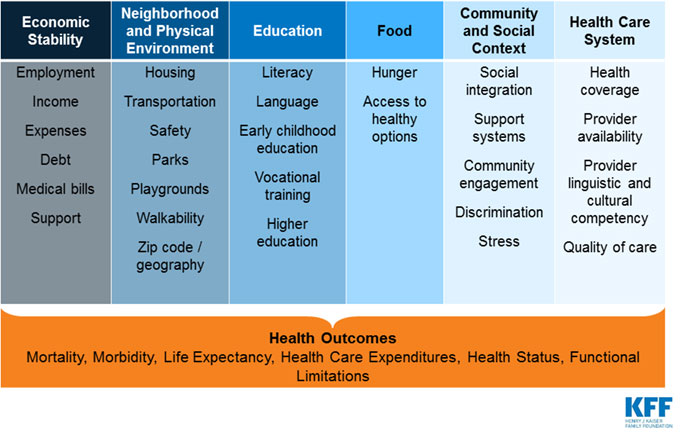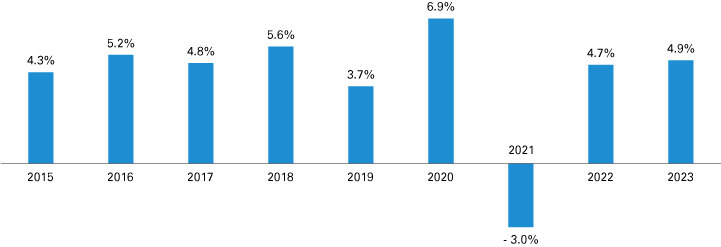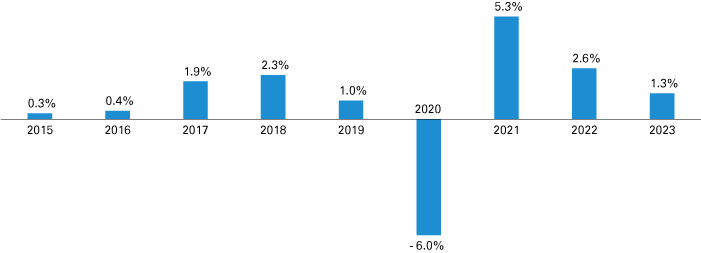Bloomington forecast 2021

President, Bloomington Economic Development Corporation

Co-director and Executive Editor, Indiana Business Research Center, Indiana University Kelley School of Business
Who knew last year about this time that a pandemic would upend lives and our economies? Essentially, no one. As we write this prognosis on the relative health of the Bloomington economy, we cannot say with any certainty how 2021 will turn out—but we do know more than we did last spring and, by combining our quantitative analysis with qualitative insights from local businesses and tying these to the region’s economic development strategies, we’re in a good position to provide a forecast and targeted insights.
Public health, economic stability and business
We have all learned firsthand how public health—and a public health crisis—can affect our economy. There is a direct link between public health and economic stability that impacts our 2021 business outlook. It seems relevant to consider the public health community’s concept about the social determinants of health, which illustrates the relationship between economic and social conditions with people’s health.
The Centers for Disease Control and Prevention (CDC) defines these social determinants as “conditions in the places where people live, learn, work and play that affect a wide range of health and quality-of life risks and outcomes.”1 Figure 1 (from the Kaiser Family Foundation) outlines the framework of these social determinants. Economic stability, neighborhood and physical environments, education, food, community and social context, and the health care system itself all influence the health outcomes of individuals and, as a result, their communities. National news in 2020 has highlighted how social determinants of health have been affected, often negatively, by the pandemic.
Figure 1: Social determinants of health

Source: Kaiser Family Foundation
It may go without saying, but we’ll say it anyway: For employers, it is critical to have a healthy, vibrant workforce and a strong community that can participate in economic activity. All local employers in the Bloomington metro that were interviewed for this article discussed the pandemic or public health in some way. Employers touched on themes that included economic stability, housing and workforce training. Our ability to influence the business outlook for 2021 relates to how well we work as a community to address these challenges.
Employer interviews
The Bloomington Economic Development Corporation (BEDC) interviewed 20 of its members and partners regarding their outlooks for 2021. These organizations represented a range of industries, with no large sample of respondents in any one industry. Therefore, responses should be seen as examples of individual employer experiences across Monroe County. Respondents represent the following industries:
- Banking
- Business and economic development
- Construction and sub-contractors in electrical, heating and cooling, and environmental assessment
- Engineering
- Financial planning
- Hospitality and tourism
- Insurance
- Life sciences
- Manufacturing
- Medical and health services
- Property development
- Real estate
Several themes emerged from these conversations.
1. The pandemic and public health overall will continue to impact business in 2021.
Almost all interviewees mentioned the pandemic. A few indicated the need to keep businesses open, with some simply noting shutdowns would change their 2021 outlook. Others noted the need to manage the pandemic, as consumers may not return to patronizing businesses if they feel unsafe. Various respondents expressed hope that a COVID-19 vaccine could help business resume as normal.
2. Industries have been impacted differently and are recovering differently.
-
Hospitality and tourism businesses have been most heavily impacted by the pandemic and are forecast to recover more slowly than other industries. This tracks with national data.
-
Medical services have been heavily impacted in 2020, with great demands on the industry. A local respondent in this field expressed an optimistic outlook for 2021, based on plans to hire additional staff to cover added demand for medical care, lessons learned through 2020 and plans for expansion in 2021.
-
A life science industry respondent indicated uncertainty for 2021. As hospitals across communities fill with COVID-19 patients, some have limited elective medical procedures, which affects demand for some medical products. However, the impact may not be as widespread as in the spring, given all that has been learned during the pandemic.
-
A manufacturing executive noted that the automotive industry is showing as stable for 2021 with sales in Indiana strong—with the caveat that another COVID-19 shutdown would change the outlook. U.S. vehicle production is projected to be lower than 2018 and 2019.
-
Local construction and subcontracting companies have noted that they will be affected by decisions on major construction and renovation projects tied to public and private funding. Recent major capital projects in Monroe County include those connected to Indiana University (IU), IU Health and the Regional Academic Health Center, expansions by Cook and Catalent, and other public projects.
-
Residential real estate remains strong, with prices continuing to rise given a lack of local housing supply and low interest rates.
-
A couple of banking executives expressed optimism or cautious optimism for 2021. One noted that federal appointments and economic policy decisions will impact the banking industry.
-
A couple of financial and retirement planning experts that were interviewed indicated strong continued demand for their services given the uncertainty brought by 2020.
3. Indiana University’s plans will continue to impact the local economy.
Some respondents indicated that IU’s pandemic response will continue to impact the local economy in 2021:
-
Student presence: Students comprise an important part of the local consumer base. IU has halted in-person classes from Thanksgiving to Feb. 7 as a pandemic precaution. During that period of time, many students will leave the community. Students also comprise part of the local workforce. Some businesses, particularly those in retail and hospitality, have noted finding fewer student staff during the pandemic.
-
Events: Decisions on IU Athletics and graduation will impact local businesses, especially in hospitality and tourism.
-
IU building and renovation projects will also continue to impact the business outlook. Companies working in construction, renovation and subcontracting are directly impacted by IU’s capital projects in 2021.
As of Nov. 6, 2020, Indiana University has indicated that beginning in February, the spring 2021 semester will employ the same in-person and online hybrid model as fall 2020, barring any major public health changes. There may be uncertainty around IU’s long-term, large capital projects, which are dictated by the Indiana General Assembly.
4. Ongoing challenges include workforce, housing and commercial properties.
-
Workforce: Some industry respondents, especially those in production and those that require direct interactions with customers, are experiencing labor shortages. These challenges began before the pandemic and intensified in 2020. With IU operating on a hybrid format and fewer students on campus, the labor pool for part-time and seasonal work is also generally smaller. Some respondents also hypothesized that individuals remain hesitant about gathering or have exited the workforce.
-
Housing: Monroe County faced pre-pandemic housing shortages, which remains a challenge through the pandemic, and prices continue to rise. A few employers noted the need to create more workforce housing, to support talent attraction and retention efforts and an affordable quality of life.
-
Commercial spaces: Simultaneously, some respondents indicated concern about empty retail spaces, which may be exacerbated by 2020 business closures, while developable land for housing and larger employers remains limited.
5. Remote work poses an opportunity for some and a challenge for others.
Most industries were forced to embrace remote work in 2020, although some essential businesses continued regular operations during the spring shutdown. Various respondents observed that businesses are adapting to new technology requirements, COVID-19 mandates and necessary business changes despite the stress and hardship involved in the process. This has brought innovation for some companies, which will persist to some degree after the pandemic. Businesses that have pivoted from in-person service to remote and delivery options have fared better. Other respondents indicated that remote work will remain a challenge in 2021, based on their industries and organizational cultures.
6. Financial stimulus would continue to help.
Local businesses with smaller reserves and narrower cash flow margins are more vulnerable as Monroe County weathers the next few months. With this in mind, a couple of respondents indicated that more financial stimulus would be helpful. The health of businesses across the community will have a ripple effect. Even companies that fared well in 2020 have indicated that their 2021 outlook is affected by businesses they serve.
Overall, there is that all-too-prevalent combination of cautious optimism and uncertainty.
Shaping the outlook
Despite national headwinds that can and do impact our community, we have an ability to influence some of the outcomes through our actions. We can band together to:
-
Minimize the spread of COVID-19 by continuing to adopt public health practices, such as social distancing and masking. This supports a healthy workforce. Consumers that feel safe are more likely to go out and patronize businesses.
-
Collaborate on shared economic development priorities and challenges: National trends have shown an increase in automation, greater interest for individuals to move away from dense cities, an increase in remote work opportunities, and the need to address social and racial inequities. Local challenges include housing, land use, and talent attraction and retention. Simultaneously, the pandemic has increased collaboration across our local health care, business, economic development, local government, nonprofit and educational institutions. We can build on this momentum to define and focus on shared priorities and challenges in 2021. No one organization or sector can solve these broad challenges alone. The more we can get ahead of these challenges and opportunities, the better positioned we will be to prosper.
-
Advance regional and state strategies: Our ability to prosper is tied to the communities around us, so the need for collaboration extends across county lines.
-
Diversify employment opportunities: Since the early 20th century, major industries in Monroe County have evolved from furniture making with the Showers Brothers Furniture Company; to manufacturing with the presence of companies like General Electric, RCA and Otis; to the rise of life sciences with major employers like Cook Group and Catelent. The pandemic has underscored a finding of earlier economic development studies: Our community and opportunities for individuals will be stronger if we can diversify our employment base to include more future-focused industries. This includes the technology industry, which can leverage innovation coming from our existing tech companies, IU and NSWC Crane.
-
Connect conversations around workforce: Employment opportunities cannot be divorced from our local labor market. While we have a wealth of organizations that help train and place workers, some employers still struggle to find quality employees. Collaboration is needed across sectors to address these challenges in a transformative way for our market.
-
Support small business: Finally, small businesses form a major component of our local culture and economy. Our support for these companies in the coming few months will have an impact for years to come.
The quantitative forecast
We expect the metro population, based on our IBRC projections, to come in at nearly 171,000 people once the 2020 census counts are released next spring or early summer. This will be an important milestone as population size underpins our economic forecasts. Unemployment in the Bloomington metro will return to pre-pandemic levels by the end of 2020, since it has already come down significantly from its high rate of 10.3% in April to 4.5% in September. Notably, the resident labor force in the metro has actually grown (81,463 as of September) compared to where it was back in January (80,951).
The pandemic-related job declines have mostly recovered from their April trough (see Table 1). Notably, the financial services sector remained essentially unchanged throughout the year, while businesses in the “other services”2 sector—that is, those not easily put into the other sectors—have not recovered to their January job levels. The sectors with substantial increases over January levels include natural resources, mining and construction (these are lumped together by the U.S. Bureau of Labor Statistics into a supersector), government (public schools, hospitals, universities and local government), and even a slight increase in hospitality services.
Table 1: Bloomington metro employment, 2020
| January | April | September | Position relative to January | |
|---|---|---|---|---|
| Nonfarm | 79,600 | 74,000 | 80,400 | Increase |
| Private | 53,000 | 47,100 | 52,900 | Almost recovered |
| Goods-producing | 12,100 | 11,200 | 12,300 | Increase |
| Service-providing | 67,500 | 62,800 | 68,100 | Increase |
| Detail by BLS supersectors | ||||
| Natural resources, mining & construction | 2,500 | 2,400 | 2,900 | Increase |
| Manufacturing | 9,600 | 8,800 | 9,400 | Almost recovered |
| Trade, transportation & utilities | 10,000 | 9,100 | 10,200 | Increase |
| Information | 1,000 | 900 | 900 | Not recovered |
| Financial activities | 3,300 | 3,300 | 3,300 | Never declined |
| Professional & business services | 5,400 | 5,200 | 5,500 | Increase |
| Private educational & health services | 10,400 | 9,800 | 10,000 | Almost recovered |
| Leisure & hospitality | 8,600 | 5,900 | 8,800 | Increase |
| Other services | 2,200 | 1,700 | 1,900 | Not recovered |
| Government (includes public schools & hospitals) | 26,600 | 26,900 | 27,500 | Increase |
Note: These data are not seasonally adjusted.
Source: Current Employment Statistics from the U.S. Bureau of Labor Statistics
Our forecast shows the overall economy for the metro declining a bit in 2021, based on our forecast of personal income, though personal income will improve in 2022 and 2023 (see Figure 2).
Figure 2: Bloomington metro personal income average annual growth rate projections

Source: Indiana University Center for Econometric Model Research
While job levels have already been recovering, we expect employment growth in 2021 to surpass 5% in 2021, with a slowing pace in 2022 (2.6%) and 2023 (1.3%), as shown in Figure 3.
Figure 3: Bloomington metro average annual growth rate in jobs forecasts

Source: Indiana University Center for Econometric Model Research
As many businesses have made pandemic-induced pivots, we anticipate continuing growth in consumption for both durable and nondurable goods, as well as those services tailored to the need for limited person-to-person interactions. Businesses in our region are showing resilience, even while there is continued uncertainty around the depth and breadth of COVID-19’s spread and impact in the year ahead. But, it is worth paraphrasing this line from earlier in the article: We can build on the lessons we learned this year to define and focus on shared priorities and challenges in 2021.
About the BEDC
The Bloomington Economic Development Corporation (BEDC) is a nonprofit corporation dedicated to the retention, development and attraction of quality jobs in Monroe County.
Economic development, at its core, works to sustainably increase prosperity and quality of life for communities. It is not growth for the sake of growth. The field focuses on creating a better economic future for all by enabling individuals, companies and communities to innovate and responsibly produce and trade valuable goods and services, by maximizing talent and resources.
Notes
- “Social determinants of health: Know what affects health,” Centers for Disease Control and Prevention, August 19, 2020, www.cdc.gov/socialdeterminants/index.htm
- Other services include equipment and machinery repairing, promoting or administering religious activities, grantmaking, advocacy, dry-cleaning and laundry services, personal care services, death care services, pet care services, temporary parking services, and dating services.



